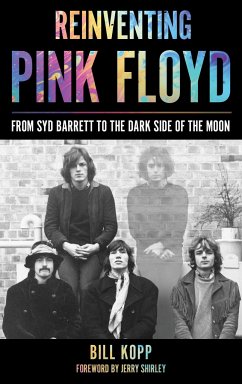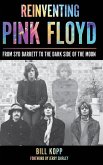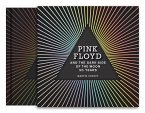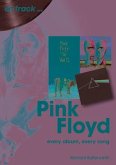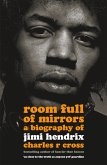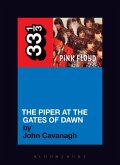- Broschiertes Buch
- Merkliste
- Auf die Merkliste
- Bewerten Bewerten
- Teilen
- Produkt teilen
- Produkterinnerung
- Produkterinnerung
In celebration of the 40th anniversary of The Dark Side of the Moon, Bill Kopp celebrates the ingenuity with which Pink Floyd rebranded themselves following the 1968 departure of Syd Barrett. Not only did the band survive Barrettâ s departure, but it went on to release landmark albums that continue to influence generations of musicians and fans.
Andere Kunden interessierten sich auch für
![Reinventing Pink Floyd Reinventing Pink Floyd]() Bill KoppReinventing Pink Floyd43,99 €
Bill KoppReinventing Pink Floyd43,99 €![Pink Floyd and The Dark Side of the Moon Pink Floyd and The Dark Side of the Moon]() Martin PopoffPink Floyd and The Dark Side of the Moon29,99 €
Martin PopoffPink Floyd and The Dark Side of the Moon29,99 €![The Routledge Handbook of Pink Floyd The Routledge Handbook of Pink Floyd]() The Routledge Handbook of Pink Floyd49,99 €
The Routledge Handbook of Pink Floyd49,99 €![Pink Floyd Pink Floyd]() Richard ButterworthPink Floyd19,99 €
Richard ButterworthPink Floyd19,99 €![Pink Floyd Live: Collected Pink Floyd Live: Collected]() Alison JamesPink Floyd Live: Collected23,99 €
Alison JamesPink Floyd Live: Collected23,99 €![Room Full of Mirrors Room Full of Mirrors]() Charles R. CrossRoom Full of Mirrors16,99 €
Charles R. CrossRoom Full of Mirrors16,99 €![Pink Floyd's the Piper at the Gates of Dawn Pink Floyd's the Piper at the Gates of Dawn]() John CavanaghPink Floyd's the Piper at the Gates of Dawn15,99 €
John CavanaghPink Floyd's the Piper at the Gates of Dawn15,99 €-
-
-
In celebration of the 40th anniversary of The Dark Side of the Moon, Bill Kopp celebrates the ingenuity with which Pink Floyd rebranded themselves following the 1968 departure of Syd Barrett. Not only did the band survive Barrettâ s departure, but it went on to release landmark albums that continue to influence generations of musicians and fans.
Hinweis: Dieser Artikel kann nur an eine deutsche Lieferadresse ausgeliefert werden.
Hinweis: Dieser Artikel kann nur an eine deutsche Lieferadresse ausgeliefert werden.
Produktdetails
- Produktdetails
- Verlag: Rowman & Littlefield
- Seitenzahl: 260
- Erscheinungstermin: 14. Oktober 2019
- Englisch
- Abmessung: 223mm x 141mm x 30mm
- Gewicht: 366g
- ISBN-13: 9781538135754
- ISBN-10: 1538135752
- Artikelnr.: 57018952
- Herstellerkennzeichnung
- Libri GmbH
- Europaallee 1
- 36244 Bad Hersfeld
- gpsr@libri.de
- Verlag: Rowman & Littlefield
- Seitenzahl: 260
- Erscheinungstermin: 14. Oktober 2019
- Englisch
- Abmessung: 223mm x 141mm x 30mm
- Gewicht: 366g
- ISBN-13: 9781538135754
- ISBN-10: 1538135752
- Artikelnr.: 57018952
- Herstellerkennzeichnung
- Libri GmbH
- Europaallee 1
- 36244 Bad Hersfeld
- gpsr@libri.de
Bill Kopp is a lifelong music enthusiast, musician, collector, and music journalist. His writing has been featured in music magazines including Bass Guitar, Record Collector, Prog, and Shindig! (all in Great Britain), as well as Billboard, Electronic Musician, Goldmine, Trouser Press, Ugly Things, and more than a dozen alternative weekly newspapers. He is the Jazz Desk Editor and Prog Editor at BLURT online and has written liner note essays for 20 albums, including titles by Julian "Cannonball" Adderley, Larry Coryell, Edgar Winter, Rick Wakeman, the Ventures, Dave Mason, and Iron Butterfly. He has interviewed several hundred musicians and music industry figures of note, and his musoscribe.com blog features thousands of music reviews, essays, and interviews. Follow him on Twitter @the_musoscribe.
Introduction Historical and musical contextualization of early Pink Floyd
with Syd Barrett as leader Discussion of the group's reliance on Barrett
Apples and Oranges: 1967- Defining characteristics in Barrett's songwriting
and musical approach This early period features a band focused almost
solely on the compositions, vocals and distinctive guitar work of Roger
Keith "Syd" Barrett, the group's original leader. The studio songs of this
period are characterized by a childlike wonder, filtered through the
influences of English classical literature and LSD. The Piper at the Gates
of Dawn and singles - Barrett's studio work as an exemplar of "Summer of
Love" musical ethosReaction in G: Cambridge St/ation - Pink Floyd's live
shows of the era were distinctly different from the band's studio output,
and would provide more of a template for the band's future direction.BBC
One: Continu/ation - Live performances for radio bridged the gap between
the band's live and studio approaches. Point Me at the Sky: 1968 - Syd
leaves; the band begins again in his shadow Reeling from the loss of both
its leader and management, Pink Floyd struggles to develop new material
that continues where Syd Barrett;s music left off. Searching for a Sound: A
Saucerful of Secrets - Losing its leader halfway through the making of an
album means Pink Floyd has to draw upon its live set for ideas. The group
quickly moves away form pop song structure.Soundtrack One: Tonite Let's All
Make Love in London - Without even trying, the band makes its first foray
into the world of film soundtrack work.BBC Two: Germin/ation and
Continua/tion - The band works hard for commercial success via multiple
television appearances and additional soundtrack work (The Committee) The
Narrow Way: 1969 - Developing a distinct identity Guitarist David Gilmour
takes on a more active role. The loss of the band's primary songwriter and
creative visionary found the group adrift artistically, searching for a new
and distinctive musical direction. Nonetheless, some of the group's most
enduring work was creative during this period of exploration and
experimentation, setting the tone for the future. Soundtrack Two: More -
Pink Floyd makes its first serious journey into the world of composiing
music for motion pictures.Live work vs. Studio Experiments: Ummagumma -
Double-album highlights the group beginning to reconcile the differences
between its live performance and studio work; the lines between the two
begin to blur.The Man and the Journey: Dramatis/ation - An early conceptual
work aims to combine scattered individual songs into a cohesive,
semi-narrative extended work, presaging The Dark Side of the
MoonRemergence: 1970 - Increased musical risks yield rewards and setbacks
Pink Floyd explores long-form musical composition in live performance while
pursuing soundtrack opportunities that showcase a different side of the
band and provide clues to the future. Epic song structure: Atom Heart
Mother - Expanding its sound to include a full orchestra and choir, the
group collaborates closely with avant-garde composer Ron Geesin.Soundtrack
Three: Zabriskie Point - The band's ambient-leaning tendencies are explored
in a suite of songs and incidental music created for film.Soundtrack Four:
Music from The Body - Album marks the first outside venture by a Pink Floyd
member (post-Syd Barret) and develops some musical ideas that will reappear
on The Dark Side of the Moon.BBC Three: Devi/ation - Developed onstage
rather than in the studio, the band's extended set-pieces preview the
direction Pink Floyd's music would take for the rest of its time as a
group. Biding My Time: 1971 - In-depth pursuit of promising musical
approaches Learning from the experience of working with a collaborator, the
group retreats into itself, combining its strengths onto a single album.
Refining the Formula: Meddle - Continuing its approach of developing
long-form musical works onstage, Pink Floyd creates one of its most
enduring work. BBC Four: Reverber/ation - Once again the band reconciles
its studio work (specifically, pop-length songs) with long-form
explorations; BBC performances of this era are the most accurate
representations of the band's growth. Odds and Ends: Relics - Scattered
non-album tracks and previously-unreleased material shows both how the band
has changed and maintained some of its original ideas. Burning Bridges:
1972 - Leaving Syd's influence behind and looking to the future A distinct
musical personality emerges, and the group once again attempts
collaboration with outside artists, most notably filmmaker Adrian Maben and
ballet choreographer Roland Petit. Soundtrack Four: La Valée (Obscured by
Clouds) - Pink Floyd embarks on its final film soundtrack project.Wot's ...
Uh the Deal: Obfusc/ation - The band attempts to combine music and ballet,
with mixed results.Echoes: Live at Pompeii - A live performance in ancient
coliseum ruins serves as the final word on Pink Floyd's transitional years,
while previewing the future. The Great Gig in the Sky: 1973 - Creating the
perfect album The synthesis of everything the band has learned in the
previous five years. Perfecting the Formula: The Dark Side of the Moon Oh,
By the Way: 1974 and Beyond Conclusion
with Syd Barrett as leader Discussion of the group's reliance on Barrett
Apples and Oranges: 1967- Defining characteristics in Barrett's songwriting
and musical approach This early period features a band focused almost
solely on the compositions, vocals and distinctive guitar work of Roger
Keith "Syd" Barrett, the group's original leader. The studio songs of this
period are characterized by a childlike wonder, filtered through the
influences of English classical literature and LSD. The Piper at the Gates
of Dawn and singles - Barrett's studio work as an exemplar of "Summer of
Love" musical ethosReaction in G: Cambridge St/ation - Pink Floyd's live
shows of the era were distinctly different from the band's studio output,
and would provide more of a template for the band's future direction.BBC
One: Continu/ation - Live performances for radio bridged the gap between
the band's live and studio approaches. Point Me at the Sky: 1968 - Syd
leaves; the band begins again in his shadow Reeling from the loss of both
its leader and management, Pink Floyd struggles to develop new material
that continues where Syd Barrett;s music left off. Searching for a Sound: A
Saucerful of Secrets - Losing its leader halfway through the making of an
album means Pink Floyd has to draw upon its live set for ideas. The group
quickly moves away form pop song structure.Soundtrack One: Tonite Let's All
Make Love in London - Without even trying, the band makes its first foray
into the world of film soundtrack work.BBC Two: Germin/ation and
Continua/tion - The band works hard for commercial success via multiple
television appearances and additional soundtrack work (The Committee) The
Narrow Way: 1969 - Developing a distinct identity Guitarist David Gilmour
takes on a more active role. The loss of the band's primary songwriter and
creative visionary found the group adrift artistically, searching for a new
and distinctive musical direction. Nonetheless, some of the group's most
enduring work was creative during this period of exploration and
experimentation, setting the tone for the future. Soundtrack Two: More -
Pink Floyd makes its first serious journey into the world of composiing
music for motion pictures.Live work vs. Studio Experiments: Ummagumma -
Double-album highlights the group beginning to reconcile the differences
between its live performance and studio work; the lines between the two
begin to blur.The Man and the Journey: Dramatis/ation - An early conceptual
work aims to combine scattered individual songs into a cohesive,
semi-narrative extended work, presaging The Dark Side of the
MoonRemergence: 1970 - Increased musical risks yield rewards and setbacks
Pink Floyd explores long-form musical composition in live performance while
pursuing soundtrack opportunities that showcase a different side of the
band and provide clues to the future. Epic song structure: Atom Heart
Mother - Expanding its sound to include a full orchestra and choir, the
group collaborates closely with avant-garde composer Ron Geesin.Soundtrack
Three: Zabriskie Point - The band's ambient-leaning tendencies are explored
in a suite of songs and incidental music created for film.Soundtrack Four:
Music from The Body - Album marks the first outside venture by a Pink Floyd
member (post-Syd Barret) and develops some musical ideas that will reappear
on The Dark Side of the Moon.BBC Three: Devi/ation - Developed onstage
rather than in the studio, the band's extended set-pieces preview the
direction Pink Floyd's music would take for the rest of its time as a
group. Biding My Time: 1971 - In-depth pursuit of promising musical
approaches Learning from the experience of working with a collaborator, the
group retreats into itself, combining its strengths onto a single album.
Refining the Formula: Meddle - Continuing its approach of developing
long-form musical works onstage, Pink Floyd creates one of its most
enduring work. BBC Four: Reverber/ation - Once again the band reconciles
its studio work (specifically, pop-length songs) with long-form
explorations; BBC performances of this era are the most accurate
representations of the band's growth. Odds and Ends: Relics - Scattered
non-album tracks and previously-unreleased material shows both how the band
has changed and maintained some of its original ideas. Burning Bridges:
1972 - Leaving Syd's influence behind and looking to the future A distinct
musical personality emerges, and the group once again attempts
collaboration with outside artists, most notably filmmaker Adrian Maben and
ballet choreographer Roland Petit. Soundtrack Four: La Valée (Obscured by
Clouds) - Pink Floyd embarks on its final film soundtrack project.Wot's ...
Uh the Deal: Obfusc/ation - The band attempts to combine music and ballet,
with mixed results.Echoes: Live at Pompeii - A live performance in ancient
coliseum ruins serves as the final word on Pink Floyd's transitional years,
while previewing the future. The Great Gig in the Sky: 1973 - Creating the
perfect album The synthesis of everything the band has learned in the
previous five years. Perfecting the Formula: The Dark Side of the Moon Oh,
By the Way: 1974 and Beyond Conclusion
Introduction Historical and musical contextualization of early Pink Floyd
with Syd Barrett as leader Discussion of the group's reliance on Barrett
Apples and Oranges: 1967- Defining characteristics in Barrett's songwriting
and musical approach This early period features a band focused almost
solely on the compositions, vocals and distinctive guitar work of Roger
Keith "Syd" Barrett, the group's original leader. The studio songs of this
period are characterized by a childlike wonder, filtered through the
influences of English classical literature and LSD. The Piper at the Gates
of Dawn and singles - Barrett's studio work as an exemplar of "Summer of
Love" musical ethosReaction in G: Cambridge St/ation - Pink Floyd's live
shows of the era were distinctly different from the band's studio output,
and would provide more of a template for the band's future direction.BBC
One: Continu/ation - Live performances for radio bridged the gap between
the band's live and studio approaches. Point Me at the Sky: 1968 - Syd
leaves; the band begins again in his shadow Reeling from the loss of both
its leader and management, Pink Floyd struggles to develop new material
that continues where Syd Barrett;s music left off. Searching for a Sound: A
Saucerful of Secrets - Losing its leader halfway through the making of an
album means Pink Floyd has to draw upon its live set for ideas. The group
quickly moves away form pop song structure.Soundtrack One: Tonite Let's All
Make Love in London - Without even trying, the band makes its first foray
into the world of film soundtrack work.BBC Two: Germin/ation and
Continua/tion - The band works hard for commercial success via multiple
television appearances and additional soundtrack work (The Committee) The
Narrow Way: 1969 - Developing a distinct identity Guitarist David Gilmour
takes on a more active role. The loss of the band's primary songwriter and
creative visionary found the group adrift artistically, searching for a new
and distinctive musical direction. Nonetheless, some of the group's most
enduring work was creative during this period of exploration and
experimentation, setting the tone for the future. Soundtrack Two: More -
Pink Floyd makes its first serious journey into the world of composiing
music for motion pictures.Live work vs. Studio Experiments: Ummagumma -
Double-album highlights the group beginning to reconcile the differences
between its live performance and studio work; the lines between the two
begin to blur.The Man and the Journey: Dramatis/ation - An early conceptual
work aims to combine scattered individual songs into a cohesive,
semi-narrative extended work, presaging The Dark Side of the
MoonRemergence: 1970 - Increased musical risks yield rewards and setbacks
Pink Floyd explores long-form musical composition in live performance while
pursuing soundtrack opportunities that showcase a different side of the
band and provide clues to the future. Epic song structure: Atom Heart
Mother - Expanding its sound to include a full orchestra and choir, the
group collaborates closely with avant-garde composer Ron Geesin.Soundtrack
Three: Zabriskie Point - The band's ambient-leaning tendencies are explored
in a suite of songs and incidental music created for film.Soundtrack Four:
Music from The Body - Album marks the first outside venture by a Pink Floyd
member (post-Syd Barret) and develops some musical ideas that will reappear
on The Dark Side of the Moon.BBC Three: Devi/ation - Developed onstage
rather than in the studio, the band's extended set-pieces preview the
direction Pink Floyd's music would take for the rest of its time as a
group. Biding My Time: 1971 - In-depth pursuit of promising musical
approaches Learning from the experience of working with a collaborator, the
group retreats into itself, combining its strengths onto a single album.
Refining the Formula: Meddle - Continuing its approach of developing
long-form musical works onstage, Pink Floyd creates one of its most
enduring work. BBC Four: Reverber/ation - Once again the band reconciles
its studio work (specifically, pop-length songs) with long-form
explorations; BBC performances of this era are the most accurate
representations of the band's growth. Odds and Ends: Relics - Scattered
non-album tracks and previously-unreleased material shows both how the band
has changed and maintained some of its original ideas. Burning Bridges:
1972 - Leaving Syd's influence behind and looking to the future A distinct
musical personality emerges, and the group once again attempts
collaboration with outside artists, most notably filmmaker Adrian Maben and
ballet choreographer Roland Petit. Soundtrack Four: La Valée (Obscured by
Clouds) - Pink Floyd embarks on its final film soundtrack project.Wot's ...
Uh the Deal: Obfusc/ation - The band attempts to combine music and ballet,
with mixed results.Echoes: Live at Pompeii - A live performance in ancient
coliseum ruins serves as the final word on Pink Floyd's transitional years,
while previewing the future. The Great Gig in the Sky: 1973 - Creating the
perfect album The synthesis of everything the band has learned in the
previous five years. Perfecting the Formula: The Dark Side of the Moon Oh,
By the Way: 1974 and Beyond Conclusion
with Syd Barrett as leader Discussion of the group's reliance on Barrett
Apples and Oranges: 1967- Defining characteristics in Barrett's songwriting
and musical approach This early period features a band focused almost
solely on the compositions, vocals and distinctive guitar work of Roger
Keith "Syd" Barrett, the group's original leader. The studio songs of this
period are characterized by a childlike wonder, filtered through the
influences of English classical literature and LSD. The Piper at the Gates
of Dawn and singles - Barrett's studio work as an exemplar of "Summer of
Love" musical ethosReaction in G: Cambridge St/ation - Pink Floyd's live
shows of the era were distinctly different from the band's studio output,
and would provide more of a template for the band's future direction.BBC
One: Continu/ation - Live performances for radio bridged the gap between
the band's live and studio approaches. Point Me at the Sky: 1968 - Syd
leaves; the band begins again in his shadow Reeling from the loss of both
its leader and management, Pink Floyd struggles to develop new material
that continues where Syd Barrett;s music left off. Searching for a Sound: A
Saucerful of Secrets - Losing its leader halfway through the making of an
album means Pink Floyd has to draw upon its live set for ideas. The group
quickly moves away form pop song structure.Soundtrack One: Tonite Let's All
Make Love in London - Without even trying, the band makes its first foray
into the world of film soundtrack work.BBC Two: Germin/ation and
Continua/tion - The band works hard for commercial success via multiple
television appearances and additional soundtrack work (The Committee) The
Narrow Way: 1969 - Developing a distinct identity Guitarist David Gilmour
takes on a more active role. The loss of the band's primary songwriter and
creative visionary found the group adrift artistically, searching for a new
and distinctive musical direction. Nonetheless, some of the group's most
enduring work was creative during this period of exploration and
experimentation, setting the tone for the future. Soundtrack Two: More -
Pink Floyd makes its first serious journey into the world of composiing
music for motion pictures.Live work vs. Studio Experiments: Ummagumma -
Double-album highlights the group beginning to reconcile the differences
between its live performance and studio work; the lines between the two
begin to blur.The Man and the Journey: Dramatis/ation - An early conceptual
work aims to combine scattered individual songs into a cohesive,
semi-narrative extended work, presaging The Dark Side of the
MoonRemergence: 1970 - Increased musical risks yield rewards and setbacks
Pink Floyd explores long-form musical composition in live performance while
pursuing soundtrack opportunities that showcase a different side of the
band and provide clues to the future. Epic song structure: Atom Heart
Mother - Expanding its sound to include a full orchestra and choir, the
group collaborates closely with avant-garde composer Ron Geesin.Soundtrack
Three: Zabriskie Point - The band's ambient-leaning tendencies are explored
in a suite of songs and incidental music created for film.Soundtrack Four:
Music from The Body - Album marks the first outside venture by a Pink Floyd
member (post-Syd Barret) and develops some musical ideas that will reappear
on The Dark Side of the Moon.BBC Three: Devi/ation - Developed onstage
rather than in the studio, the band's extended set-pieces preview the
direction Pink Floyd's music would take for the rest of its time as a
group. Biding My Time: 1971 - In-depth pursuit of promising musical
approaches Learning from the experience of working with a collaborator, the
group retreats into itself, combining its strengths onto a single album.
Refining the Formula: Meddle - Continuing its approach of developing
long-form musical works onstage, Pink Floyd creates one of its most
enduring work. BBC Four: Reverber/ation - Once again the band reconciles
its studio work (specifically, pop-length songs) with long-form
explorations; BBC performances of this era are the most accurate
representations of the band's growth. Odds and Ends: Relics - Scattered
non-album tracks and previously-unreleased material shows both how the band
has changed and maintained some of its original ideas. Burning Bridges:
1972 - Leaving Syd's influence behind and looking to the future A distinct
musical personality emerges, and the group once again attempts
collaboration with outside artists, most notably filmmaker Adrian Maben and
ballet choreographer Roland Petit. Soundtrack Four: La Valée (Obscured by
Clouds) - Pink Floyd embarks on its final film soundtrack project.Wot's ...
Uh the Deal: Obfusc/ation - The band attempts to combine music and ballet,
with mixed results.Echoes: Live at Pompeii - A live performance in ancient
coliseum ruins serves as the final word on Pink Floyd's transitional years,
while previewing the future. The Great Gig in the Sky: 1973 - Creating the
perfect album The synthesis of everything the band has learned in the
previous five years. Perfecting the Formula: The Dark Side of the Moon Oh,
By the Way: 1974 and Beyond Conclusion

